14
Iced up on the MatapediaCirca 1943
Atlantic Ocean
 Credits:
Credits:Herbert Roberts Collection
2007-2008 Album, Crow's Nest
15
Matapedia Iced Up1943
Atlantic Ocean
 Credits:
Credits:Herbert Roberts Collection
2007-2008 Album, Crow's Nest
16
Breaking Ice on the MatapediaCirca 1942
Atlantic Ocean
 Credits:
Credits:Herbert Roberts Collection
2007-2008 Album, Crow's Nest
17
Iceberg off St. John'sCirca 1942
St. John's, Newfoundland, Canada
 Credits:
Credits:Herbert Roberts Collection
2007-2008 Album, Crow's Nest
18
Icebergs Near St. John's HarbourCirca 1941
St. John's Harbour, Newfoundland
 Credits:
Credits:Patrick Griffiths Collection
2007-2008 Album, Crow's Nest
19
Icebergs near St. John's HarbourCirca 1941
St. John's Harbour, Newfoundland
 Credits:
Credits:Patrick Griffiths Collection
2007-2008 Album, Crow's Nest
20
On the Triangle Run1943
Atlantic Ocean
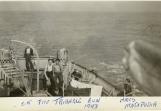 Credits:
Credits:Herbert Roberts Collection
2007-2008 Album, Crow's Nest
21
Diver at WorkCirca 1942
St. John's, Newfoundland, Canada
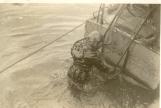 Credits:
Credits:Herbert Roberts Collection
2007-2008 Album, Crow's Nest
22
Shell Tanker "Diala" Torpedoed driftingFebruary 1941
About 400 miles East of St. John's, Newfoundland
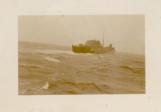 Credits:
Credits:2007-2008 Album, Crow's Nest
#2527050
23
Shell Transport Tanker "Diala" Torpedoed driftingFebruary 1941
About 400 miles East of St. John's, Newfoundland
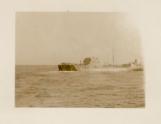 Credits:
Credits:#2527050
2007-2008 Album, Crow's Nest
24
Battling Seasickness to Capture the"Triangle Run" on FilmCirca 1942
Atlantic Ocean
 Credits:
Credits:Herbert Roberts Collection
Gary Green
Jacquey Ryan
2007-2008 Album, Crow's Nest
25
My name is Herb Roberts. I joined in Winnipeg in 1940 and I served on HMCS Matapedia, commissioned HMCS Whitby and then I served on HMCS Burlington. The first two were corvettes and the third was a minesweeper, that was in Dec. 1941, just before Christmas and we took our first convoy to Iceland, I just became acclimatized to the ship when we were tied up I didn't get sick and recognized there was a form of sickness called seasickness, it wasn't put on. He was one of our radar operators and we never saw him from the time we left Halifax until we got to Iceland because he went underneath the cabinet and stayed there all the way, actually I think a couple of the officers thought he was going to die he was kinda force fed and he couldn't keep anything down, and when we got to Iceland we put him on HMS Heckle, it was the supply ship and they had medical services and as you said they said he wasn't sick when he was aboard the Heckler but on the way back he got sick again and that's when they took him off and did all the tests on him (and led to the development of the seasickness pill), that's true.26
Patrick Edward Griffith's Rating CardCirca 1940
St. John's, Newfoundland, Canada
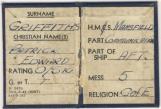 Credits:
Credits:Patrick Griffiths Collection
2007-2008 Album, Crow's Nest